Content
Published:
This is an archived release.
Sami in Norway
The Sami are an indigenous people who live in Norway, Sweden, Finland and Russia. Because there is no overall registration of the Sami population, no one knows exactly how many Sami there are today. The Sami are scattered throughout the country, but the most concentrated Sami settlement areas are north of Saltfjellet.
| 2013 | Change in per cent | ||
|---|---|---|---|
| 2012 - 2013 | 1990 - 2013 | ||
| Norway North of Saltfjellet - total | 396 532 | 0.9 | 4.2 |
| STN area - total | 55 652 | 0.0 | -14.6 |
| Other areas - total | 340 880 | 1.0 | 8.1 |
| Øst-Finnmark | 24 730 | 1.0 | -6.8 |
| Øst-Finnmark, STN | 3 789 | -0.1 | -21.6 |
| Øst-Finnmark, other areas | 20 941 | 1.2 | -3.6 |
| Indre Finnmark | 12 512 | -0.2 | -5.7 |
| Indre Finnmark, STN | 12 512 | -0.2 | -5.7 |
| Vest-Finnmark | 37 292 | 1.4 | 8.6 |
| Vest-Finnmark, STN | 3 843 | -0.3 | -34.4 |
| Vest-Finnmark, other areas | 33 449 | 1.6 | 17.5 |
| Nord-Troms | 18 480 | 0.0 | -9.5 |
| Nord-Troms, STN | 18 480 | 0.0 | -9.5 |
| Nord-Troms, other areas | 0 | . | . |
| Sør-/Midt-Troms | 141 938 | 1.3 | 12.5 |
| Sør-/Midt-Troms, STN | 14 270 | 0.2 | -16.7 |
| Sør-/Midt-Troms, other areas | 127 668 | 1.4 | 17.1 |
| Nordre Nordland | 161 580 | 0.6 | 1.1 |
| Nordre Nordland, STN | 2 758 | 0.6 | -24.0 |
| Nordre Nordland, other areas | 158 822 | 0.6 | 1.7 |
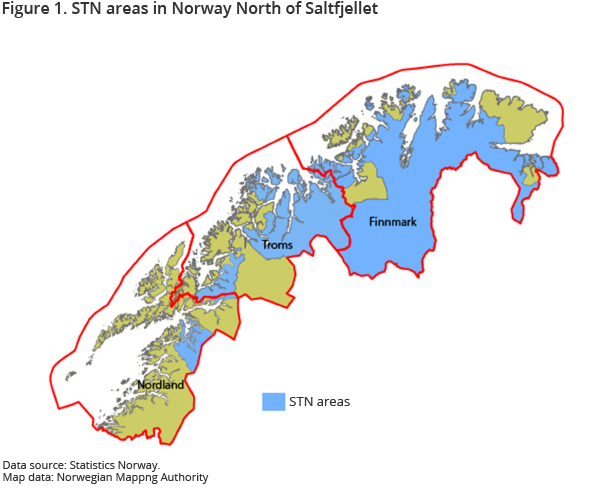
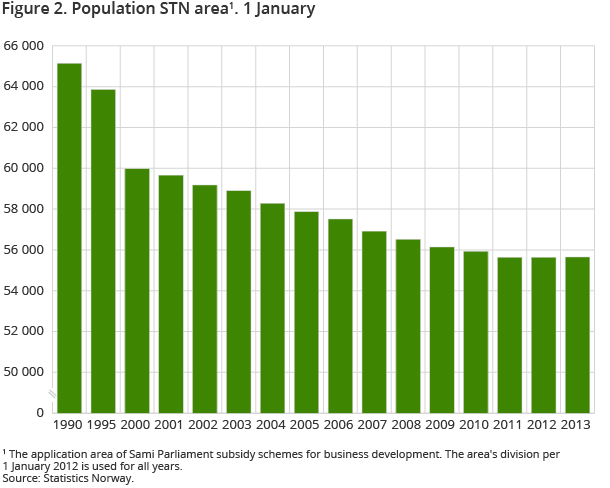
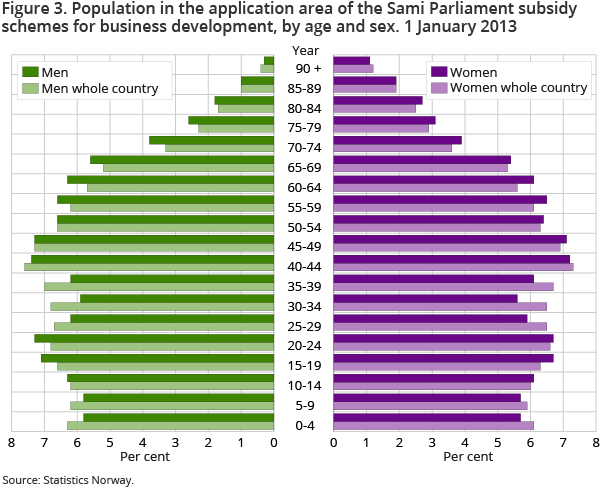
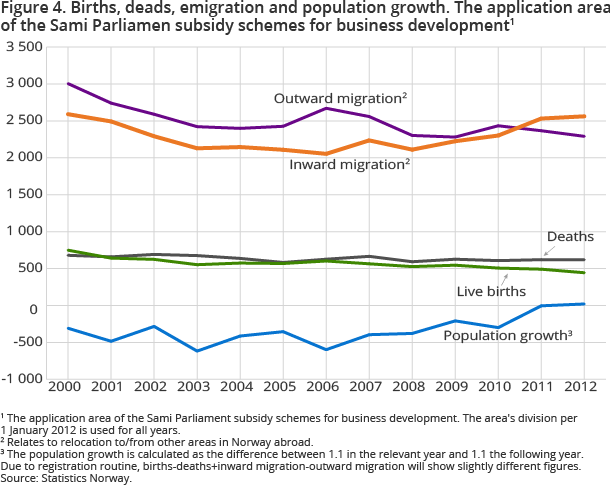
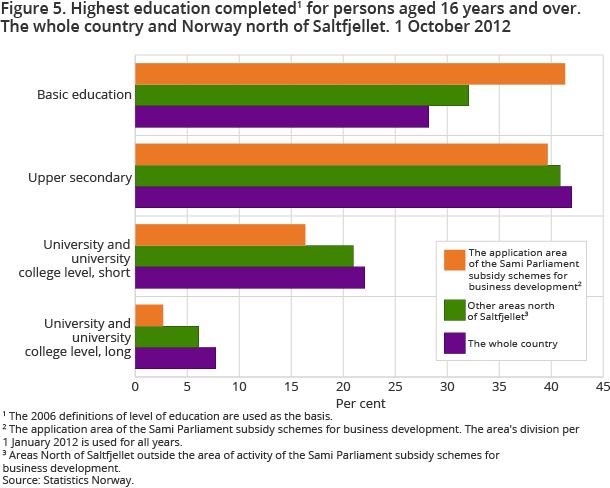
The report Sami statistics 2014 (in Norwegian only) presents statistics that are relevant to Sami society in Norway. The statistics have a primarily geographical approach, with emphasis on Sami settlement areas north of the Saltfjellet mountain range, which lies on the Arctic Circle. The area is called the area of the Sami Parliament subsidy schemes for business development (STN). The report contains statistics about Sami Parliament elections, population, education, Sami language in kindergarten and school, income, employment, reindeer herding, agriculture and fishing.
The precursor of the STN-area was the Development fund for the central Sami settlement areas. When the Norwegian Parliament created this fund in 1975, it included five municipalities in Indre Finnmark. The fund’s area of geographical activity has subsequently been extended several times, most recently in 2012. By 2013 the STN-area comprises 21 entire municipalities and 10 municipal subareas. Of these 31 municipalities, 13 are in the county of Finnmark, 14 in Troms and 4 in the northern part of Nordland.
The STN-area accounts for around 60 per cent of the area in Norway north of Saltfjellet, but only for 14 per cent of the population. Of those who live in densely populated regions north of Saltfjellet, 7 per cent live in the STN-area and 93 per cent live in the rest of the area. This is on the outskirts of Norway north of Saltfjellet, which is defined as a Sami settlement area. All the towns and larger communities are outside the STN-area.
Stable population the last years
As of 1 January 2013, 55 700 persons lived in the STN-area. The population decreased by 15 per cent from 1990 to 2013, and every year in the period 2000-2012 more people moved out of the area than in to it. While most of those who move out of the area are young, the area has got an older population than the rest of the country, with a higher number of people aged 55 years or more. Also the number of people aged 25-39 years in the STN-area is smaller than in the whole country, for both men and women. This also leads to fewer children in the age group 0-9 years in the STN-area than in the whole country.
However, the fall in the population seems to have stopped, at least temporarily. In 2011 and 2012 there were more people moving in to the STN-area than out. In 2012 there was for the first time a little increase in the number of population. In the period 2011 to 2013 the figure of population has been stable at around 55 600.
Fertility among women in the STN-area was higher than for women in the rest of the country until 2002, since then it has been lower, except for the years 2005 and 2006.
Life expectancy is somewhat lower for both sexes in the STN-area than for the whole country. A girl born in the STN-area in 2013 can expect to live 83.4 years, and a boy 77.1 years. For the country as a whole, the figures are 83.4 and 79.4 years respectively. Life expectancy in the rest of the area north of Saltfjellet is lower for men than in the whole country, while it is somewhat higher for women.
Educational level
In the STN-area, 81 per cent have education at basic school level or below secondary level as their highest education. The equivalent is 70 per cent in the country as a whole. About one of four women in the STN-area has tertiary education, and among men there are about one of seven with tertiary education. The educational level in the STN-area is lower than in other areas north of Saltfjellet and in the country as a whole.
Native language
As of 1 October 2012 there were 2 126 pupils in the below upper secondary school with Sami language as a school subject. 930 pupils had Sami as their 1st language. The figure of pupils with Sami as their 1st language is stable, while the figure of pupils with Sami as their 2nd language has decreased with 42 per cent since 2005. The last few years it has been quite stable.
Employment
65 per cent of people aged 15-74 years in the STN-area were employed 4th quarter 2012. This figure is somewhat lower than for the rest of the area north of Saltfjellet. In the country as a whole 69 per cent of the population aged 15-74 years were employed. In the STN-area the number of men who work in agriculture, forestry and fishing are significantly higher than for the rest of the area north of Saltfjellet and the country as a whole.
Otherwise, the majority of the men work in wholesale and retail trade, hotels and restaurants and construction, while the majority of women work in health and social services, not unlike the country as a whole.
The making of the Sami statisticsOpen and readClose
Because there is no overall registration of the Sami population, it is difficult to generate statistics on the Sami as a group. The statistics here have been drawn up based on the geographic range for the application area of the Sami Parliament subsidy schemes for business development (STN). The Sami population south of Saltfjellet is not included in the statistics since the Sami settlement here is so spread out that areas with Sami settlements are not regarded as Sami local communities, and it would be difficult to create geographically-based statistics from this. One result of such a geographic division is that persons within the STN-area that do not regard themselves as Sami are included in the statistics. Correspondingly, Sami who live outside the STN-area are not included.
Contact
-
Anders Sønstebø
E-mail: anders.sonstebo@ssb.no
tel.: (+47) 46 66 37 74
-
Christian Sørlien Molstad
E-mail: christian.molstad@ssb.no
tel.: (+47) 46 65 99 12
-
Statistics Norway's Information Centre
E-mail: informasjon@ssb.no
tel.: (+47) 21 09 46 42
